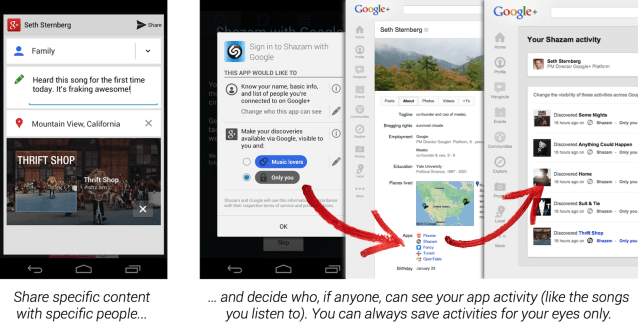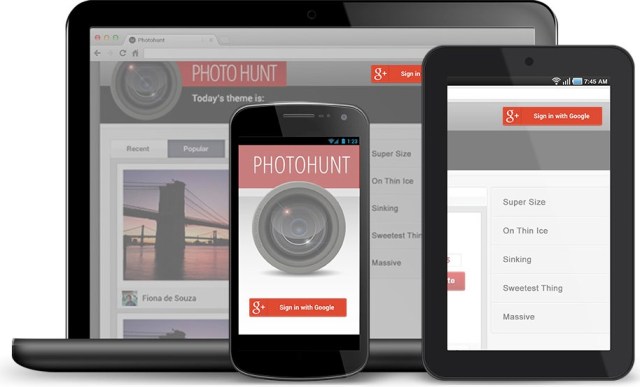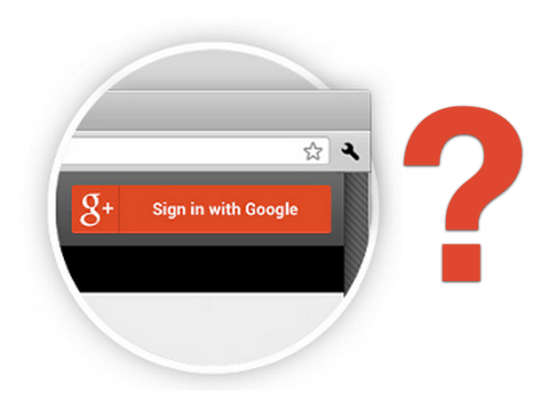Growth, to reach more users, and data, to improve the experience. That’s what apps need in an identity and social system. They’re what Facebook and Twitter deliver, and what the new Google+ Sign-In can’t without completed profiles, the social graph, and eyeballs. Logging into apps with your Google credentials would be convenient, but developers may be reluctant to offer the option.
Reading today’s pre-briefed coverage of Google’s new competitor to Facebook Connect and Twitter authorization, it feels a bit like reporters drank the Kool-Aid. The spotlight was kept on ease, security, nifty features, and lack of spam. These are legitimate advantages, and Google did well to capitalize on them. If I wanted to simply and securely sign in to an asocial third-party app rather than create yet another account, I might very well choose Google for the peace of mind.
Most people already have a Google account, and know their password well. Google has a great reputation for security, which Facebook and Twitter can’t say, and supports two-factor authentication. Ownership of Android lets Google+ Sign-In enable one-click app downloads from websites you’ve already approved, and there’s integrated Hangouts. Finally, Google hammers home the idea that it won’t “social spam” your friends like Facebook does. The search giant trumps up its Circles for selective sharing, and derides Facebook’s “frictionless” Open Graph posts that certainly rubbed a lot of people the wrong way.

Google’s Problem Is People, Not Technology
Unfortunately, lurking in the shadows are Google+’s shortcomings. Let’s face it. Most people do not have richly filled-out Google+ profiles with data to personalize apps they sign in to. They don’t have an accurate Google+ graph of their friends or influencers to import to populate apps with people to view content from or play/communicate with. And most importantly, they don’t spend enough time browsing Google+ to discover apps there.
As I said before, if I logged into an app I planned to use solo, Google+ might get the job done. But if I logged into a social app with Google+ Sign-In, it wouldn’t have the data necessary to give me a good time.
 Let’s say I wanted to use the radio app TuneIn (hypothetical because most Google+ Sign-In launch partners don’t actually offer this new login option yet). It wouldn’t know which bands I Like or follow because those artists don’t have, use, or promote their G+ accounts so I haven’t encircled them. My Google+ Circles are a scattershot of tech early adopters and professional contacts with just a few actual friends, so it wouldn’t know whose listening activity I’d care to see. And finally, if I took the time and jumped through the friction-full hoops to share what I’m hearing to Google+, few people I care about would see it. They just don’t visit the G+ feed enough.
Let’s say I wanted to use the radio app TuneIn (hypothetical because most Google+ Sign-In launch partners don’t actually offer this new login option yet). It wouldn’t know which bands I Like or follow because those artists don’t have, use, or promote their G+ accounts so I haven’t encircled them. My Google+ Circles are a scattershot of tech early adopters and professional contacts with just a few actual friends, so it wouldn’t know whose listening activity I’d care to see. And finally, if I took the time and jumped through the friction-full hoops to share what I’m hearing to Google+, few people I care about would see it. They just don’t visit the G+ feed enough.
This is a crummy user experience, and it’s no better for TuneIn’s developer. It doesn’t learn much about me to refine its sense of its user base. Without the proper social graph of my friends on the app, TuneIn couldn’t show them my activity to keep them engaged and coming back. Its stance against “social spam” kills off chances to lure in new users before I even post. And the posts I do push go to a black hole that probably won’t drive downloads like sharing to Facebook or Twitter.
To succeed in app development you need distribution and data to build something worth recommending. Without these there’s little incentive to go through the process of building in Google+ Sign-In. Larry and Sergey’s social network needs this kind of shared content to make it a destination, though, so its understandable why they launched this. A lot of devs will ignore it. Those that do integrate will likely do so alongside Facebook and Twitter, not instead of them, though there is some risk for devs of users choosing Google+ instead of the more viral options.
Google+ Sign-In looks good on paper, and it’s smart for the search giant to get more serious about the identity space. If Facebook and Twitter didn’t exist, this could get popular, and because they do, Google needs to make a move. Finally, there are some social clusters active on Google+ and they will get social sharing benefits if they’re allowed to log in with it
But Google+ Sign-In’s problems stem from a late and lackluster entry into social networking, and Google can’t just engineer solutions.
